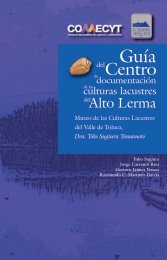You also want an ePaper? Increase the reach of your titles
YUMPU automatically turns print PDFs into web optimized ePapers that Google loves.
KORPUS <strong>21</strong>, VOL. 2, NÚM. 4, 20<strong>21</strong>, 201-<strong>21</strong>8<br />
Friedan and others further antagonized<br />
fellow attendees when they arrogated to<br />
themselves the right to represent the NGO<br />
tribune to the governmental conference,<br />
presuming to speak for an authentic feminism<br />
(Olcott, 2017).<br />
Source: Carrillo (1975: 5).<br />
Figure 3<br />
“Modern Ideas”<br />
The Mexican press responded with an<br />
attack on US feminism as an imperialist<br />
import, expressing particular alarm about<br />
SCUM, referring to Valeria Solanas’s satirical<br />
proposal for radical feminism. 8 In the apparent<br />
belief that the SCUM Manifesto spoke<br />
for an actual, existing organization, El Universal<br />
editorialized:<br />
This newspaper became aware yesterday of<br />
this strange feminist body, apparently formed<br />
in the United States, and, not least because of<br />
its originality, cannot refrain commenting […]<br />
As humor, it can pass; as a feminist organization<br />
that is supposed to be serious and worthy<br />
of respect, it is controversial to say the<br />
least (Anonymous, 1975d: 5).<br />
Perhaps someone informed the editorial<br />
board that SCUM was not an organization<br />
8 Solanas self-published S.C.U.M. Manifesto in 1967.<br />
The first commercially published edition appeared<br />
the following year as (Solanas, 1968). Solanas is most<br />
notorious for 1968 attempt to murder the artist Andy<br />
Warhol.<br />
but merely a figment of Solanas’s very active<br />
imagination. The following day, the<br />
journalist Miguel Bueno wrote an editorial<br />
the explaining that SCUM was “not a very<br />
broad” organization but insisting that it was<br />
no joke but rather a serious warning about<br />
the threat of extremist feminism (Bueno,<br />
1975: 4). 9<br />
At the NGO tribune, participants coalesced<br />
into two factions: the United Women<br />
of the Tribune (led by US feminist Betty<br />
Friedan and the Mexican feminist Esperanza<br />
Brito de Martí) and the Women against<br />
Imperialism (for whom the Bolivian militant<br />
Domitila Barrios de Chungara emerged as<br />
a standard-bearer). 10 Some demands were<br />
common across these groups: reproductive<br />
freedom, juridical equality, political representation,<br />
and an end to the commercial<br />
objectification of women. But the Marxist<br />
group stressed concerns that the feminists<br />
either had not considered or dismissed as<br />
too “political,” such as protection for migrant<br />
workers, socialization of reproductive<br />
labors, freedom for political prisoners, and<br />
social security for rural women. 11 As tensions<br />
mounted between and within the caucuses<br />
–and participants argued over where<br />
the dividing line lay between politics and<br />
women’s issues or whether such a division<br />
existed at all– another fault line appeared.<br />
An Australian student named Laurie Bebbington<br />
stood up, “amid whistles and jeering,”<br />
and nervously read from a prepared<br />
text she had titled “Lesbian Speech”.<br />
Sexuality per se had not been on any<br />
official agenda in Mexico City, apart from<br />
passing attention to the often-conflated issues<br />
of prostitution and trafficking and the<br />
nearly obsessive concern with fertility and<br />
population control. Questions about pleasure<br />
and desire and even sexual identification<br />
only fueled concerns that the UN operated<br />
9 It is worth remembering that concerns about “extremism”<br />
ran high in Mexico in the mid-1970s. Just a year<br />
earlier, Echeverría’s father-in-law had been abducted<br />
the summer before, and left-wing guerril<strong>las</strong> and paramilitary<br />
groups had escalated violence over the late<br />
1960s and early ‘70s. See, for example, Cedillo and<br />
Calderón (2012).<br />
10 See AGN, 1975c.<br />
11 For a list of the groups demands, see AGN w.d.<br />
209



![bicentenario_1[V2]](https://img.yumpu.com/68677971/1/167x260/bicentenario-1v2.jpg?quality=85)
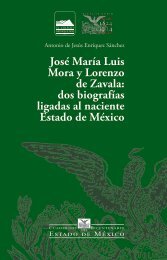
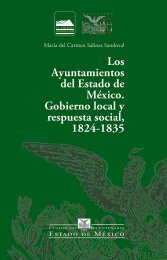

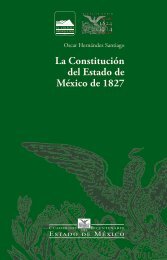
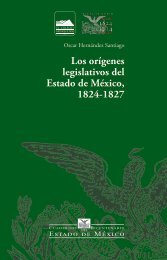
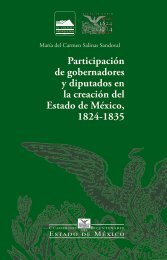
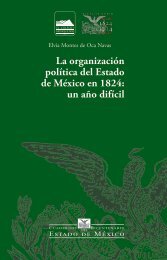
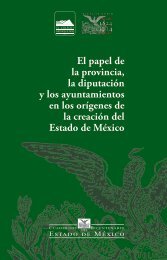

![El_primer_federalismoEM[final]_compressed (2)](https://img.yumpu.com/68483279/1/178x260/el-primer-federalismoemfinal-compressed-2.jpg?quality=85)


